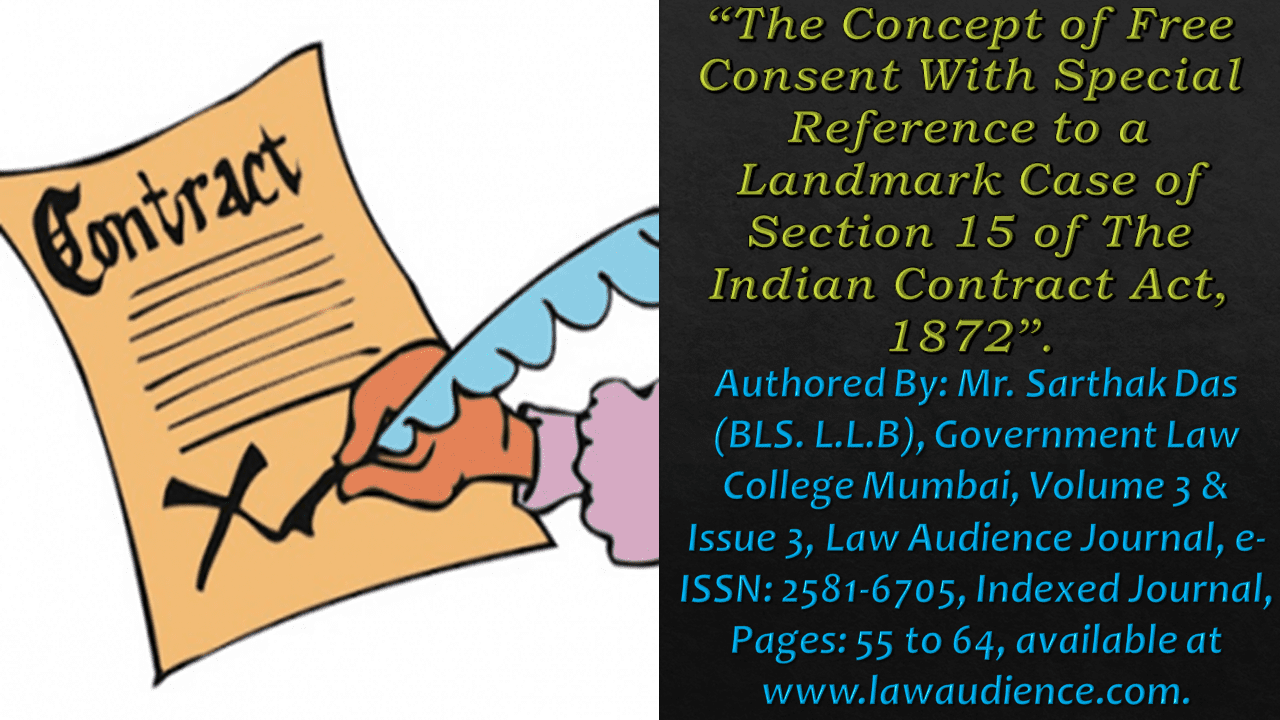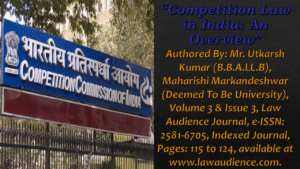Click here to download the full paper (PDF)
Authored By: Mr. Sarthak Das (BLS. L.L.B), Government Law College Mumbai,
Click here for Copyright Policy.
ABSTRACT:
“Section 15 of the Indian Contract Act, 1872 deals with one of the vitiating factors of free consent to an agreement, that is coercion. This paper deals with one of the landmark cases in relation to the particular section. The case in question is Chikkam Ammiraju And Ors. vs Chikkam Seshamma And Anr. The paper discusses the provisions of the Contract Act relating to Free Consent and the factors vitiating it. The facts of the case, the judgement and the rationale are also analysed. A critical analysis of the judgement is done at the end of the paper”.
I. INTRODUCTION:
Chikkam Ammiraju And Ors. vs Chikkam Seshamma And Anr [1], is a case that deals primarily with Section 15 and of the Indian Contract Act, 1872. The case revolves around the topic of Coercion as defined under Section 15 of the Indian Contract Act, 1872.
A Contract is defined as an agreement enforceable by the law.[2] Under Chapter II, and Section 10 of the Indian Contract Act, the requirements needed for an agreement to be called a contract are mentioned. As per the provisions of the law;
“What agreements are contracts. —All agreements are contracts if they are made by the free consent of parties competent to contract, for a lawful consideration and with a lawful object, and are not hereby expressly declared to be void.”
As can be seen from the above provision, there are five essential elements for an agreement to be called a legally binding contract. They are;
- Free Consent of the Parties
- Competency of the Parties to the Contract
- Lawful Consideration
- Lawful Object
- Not expressly declared to be void by the law
In this research paper, our concern is with discussing the aspects of the first essential element as mentioned above, that is, the free consent of the parties to a contract. In furtherance of this, the legal provisions regarding consent and free consent are defined in Section 13 and 14 of the Indian Contract Act respectively.
Section 13 defines consent as follows; Two or more persons are said to consent when they agree to the same thing in the same sense. It can be summarised through the maxim “consensus ad idem”, i.e., a meeting of the minds.
Moving forward to Section 14, which deals with ‘free consent’. As has already been noted, free consent of the parties to a contract is sine qua non for a contract to be valid in the eyes of the law. As per the Indian Contract Act, 1872, Free Consent is defined as follows;
“Free consent” defined. —Consent is said to be free when it is not caused by—
(1) coercion, as defined in section 15, or
(2) undue influence, as defined in section 16, or
(3) fraud, as defined in section 17, or
(4) misrepresentation, as defined in section 18, or
(5) mistake, subject to the provisions of sections 20, 21 and 22.
Consent is said to be so caused when it would not have been given but for the existence of such coercion, undue influence, fraud, misrepresentation or mistake. As can be seen from the above definition, free consent is defined negatively in the Contract Act, which basically means that the absence of the five conditions of Coercion or Undue Influence or Fraud or Misrepresentation or Mistake makes the contract a valid one. These can be said to be the factors that vitiate consent of the parties to a contract.
Flowing from this, If the consent of one of the parties is not free consent, i.e., it has been caused by one or the other of the above stated factors, the contract is not a valid one. When consent to an agreement is caused by coercion, undue influence, fraud or misrepresentation, the agreement is a contract voidable at the option of the party whose consent was so caused.[3]
For example, A person is induced to enter into an agreement on the basis of fraud, he may, upon discovering the fact either uphold the contract or reject it. If the contract is not rejected, it becomes legally binding on both parties. If, however, the consent has been caused by mistake, the agreement is void.[4] [5] The first condition, which must be absent for consent to be free, is that consent should not have been obtained through coercion under Section 15 of The Indian Contract Act, 1872.
Coercion is defined as follows:
“Coercion” is the committing, or threatening to commit, any act forbidden by the Indian Penal Code (45 of 1860) or the unlawful detaining, or threatening to detain, any property, to the prejudice of any person whatever, with the intention of causing any person to enter into an agreement.[6]
From the definition of “coercion”, we can identify the following essential characteristics of the crime of coercion. Coercion can be said to be caused when the consent of one of the parties to the agreement has been caused either by
- Committing or threatening to commit any act forbidden by the Indian Penal Code, 1860 or
- By unlawfully detaining or threatening to detain any property
Moreover, such an act should be to the prejudice of any person whatsoever.
II. FACTS OF THE CASE:
Chikkam Ammiraju and five others were the defendants, the first defendant was the younger brother of the husband of the first plaintiff i.e., Chikkam Seshamma. The first plaintiff and the second plaintiff had alleged that the property in possession of the defendants, originally belonged to the father of the first plaintiff, who is now deceased. The widow of the plaintiff’s father (the plaintiff’s mother) had alienated the property to the defendants without any justification. As a result, the plaintiff sued to set aside the same and got a decree that the alienation was not binding on the reversion.[7]
In furtherance of this, the husband of the first plaintiff and father of the second plaintiff was pressured by his younger brother and father (the defendants). As a result, the husband of the first plaintiff threatened to commit suicide in case, his wife and son did not execute a deed of release of property in favour of his brother. In consequence of this threat by the husband of the first plaintiff, she was made to transfer the said properties through a deed to the brother of her husband. It was this transfer that was then intended to be reversed by the plaintiffs.
II.I KEY ISSUES INVOLVED:
The fundamental questions that were before the court, when the appeal was filed by the plaintiff were;
- Whether a threat to commit suicide would constitute an act of Coercion or Undue Influence or both under Section 15 and 16 of the Indian Contract Act?
- Whether suicide was an act “forbidden by the Indian Penal Code” or not?
- If the act of threatening to commit suicide could have prejudiced the plaintiff?
II.II CONTENTIONS RAISED:
The defendants contended inter alia that no such threat of committing suicide was given. However, the lower court found that threat was used and held that it amounted to coercion under Section 15 of the Indian Contract Act, and gave a decree in favour of the plaintiffs. The defendants then proceeded to file a second appeal in the High Court. Sadasiva Ayyar, J., agreeing with the lower Courts dismissed the appeal. Mooeb, J., held that the threat held out did not in law amount to coercion or undue influence and allowed the appeal. The result was that the second appeal was dismissed under section 98, Civil Procedure Code. The defendants then filed this Appeal under Section 15 of the Letters Patent from the judgment of Sadasiva Ayyar J.[8]
Fatanjali Sastri for the appellants argued that suicide is not an offence which is punishable under then Indian Penal Code, so Section 15 of the Indian Contract Act should not apply in this case. Moreover, the counsel argued that ‘Prejudice in section 16 means some detriment to property and not any sentimental grievance as in this case.
G, Yenkatarcumayya was the counsel for the respondent argued that Section 15 mentions ‘an act forbidden by the Indian Penal Code’ and not of an offence punishable under the Indian Penal Code. He further argued that suicide is an act that is forbidden by the Indian Penal Code, 1860 as the attempt or abetment of suicide is punishable by law. Moreover, he countered the argument of his learned opponent by stating how prejudice is not limited to ‘prejudice against property alone’. He argued that “section 15 provides for an exception where freedom of consent is absent and any circumstance which influences the mind of a party to a contract and destroys the freedom of volition would constitute coercion.”[9] Flowing from this he asserted that the loss of a husband to a wife or father to a son, both of which would have occurred had the threat to suicide been successful, would amount to sufficient coercion in the eyes of the law.
II.III JUDGEMENT:
The judgement to the second appeal filed under Section 15 of the Letter Patent Act was decided by a three-judge bench of the Madras High Court. The bench consisted of Chief Justice Wallis, Justice Oldfield and Justice Seshagiri Aiyar. Wallis CJ and Aiyar J formed the majority opinion in this case with Oldfield J being the sole dissenting judge. Wallis CJ. disagreed emphatically with the assertion that a threat to commit suicide cannot be considered as an act ‘forbidden by the Indian Penal Code’. He argued that “At common law suicide was a form of homicide. “Homicide properly so called” says Hawkins, (Pleas of the Crown, Book I, Chapter 9) “is either against a man’s own life or that of another.”
He further stated that Section 299 of the Indian Penal Code, which deals with the crime of Culpable Homicide is “sufficiently wide to cover deliberate suicide”, however he accepted that punishment for culpable homicide can only been given to a living offender, a scenario which is not possible in the case of suicide. He mentioned how abetment and attempting to commit suicide are both punishable under Section 304 and Section 309 of the Indian Penal Code respectively.
He concluded his reasoning by stating “I find it impossible to hold that an act which it is made punishable to abet or attempt is not forbidden by the Indian Penal Code, especially as the absence of any section punishing the act itself is due to the fact that the suicide is in the nature of things beyond the jurisdiction of the Court.” Seshagiri Aiyar, J. agreed with the opinion of the Chief Justice. He added to the majority opinion by mentioning how the only reason the law cannot punish a person who commits suicide is because the law cannot reach him. He added how if a person either abets or attempts to commit the same crime, he is appropriately given punishment.
However, it must be noted that even Seshagiri Aiyar J. agreed to the fact that “there is no provision in the Indian Penal Code which forbids in terms commission of suicide.” He stated how the term forbidden by the Indian Penal Code is wider in meaning than the term “punishable by the law”, therefore he concluded that a threat to commit suicide can be construed to mean an act forbidden by the Indian Penal Code.
Both the judges agreed upon the fact that the act of the husband dying leaving a widow and a child with no father, in case a deed is not furnished which deprives the wife and child of their rightful property amounts to sufficient coercion under the eyes of the law.
Justice Oldfield was the sole dissenting judge, forming the minority opinion. He argued that since the act of suicide is not explicitly forbidden by the law, the only way to consider it as forbidden is by implication. He opted for a strict interpretation of the statutes. He argued that if the word ‘attempt’ is used in the legal sense, a threat to commit suicide is completely different from an attempt to suicide. He stated that “an attempt in the legal sense can be recognised as such only after the criminal’s intention has been frustrated, not when it is expressed; that is, when the threat is made.”[10]
He then turned to Section 16 which deals with Undue Influence and found no relevance to the case, as Section 16 clearly states that “one of the parties is in a position to dominate the will of the other”[11]. Since the husband was the one making the ‘threat’ and he was not one of the parties to the contract, the question of undue influence being used fails.
In relation to the above, it is important to point out how in the first appeal against the judgement of the lower court, the same issue was at hand. At that time, Justice Moore stated the example of a landmark case – Ranganayakamma vs. Alwar Setti[12]. In this case the dead body of the husband was not allowed to be removed from the house by the relatives of a boy, unless the widow legally adopted the boy aged thirteen years.
Justice Moore wrote in his judgement “In the Madras case however there would have been no difficulty in finding that the widow’s consent was obtained by “undue influence,” within the meaning of Section 16 of the Contract Act. As regards the question whether the release deed was brought about by “undue influence,” it may be that Swami was in a position to dominate his wife’s will but he was not a party to the contract and Section 16(2)(b) of the Contract Act consequently does not apply.” Simply meaning that since he was not a party to the contract, no question of undue influence arises in this case as opposed to Ranganayakamma vs. Alwar Setti.[13]
III. LAW COMMISION REPORT:
The Law Commission of India, in its 13th Report[14], suggested amendments to Section 15 of the Indian Contract Act. This suggestion was made with the aim of overcoming the lacunae that exists in the language of the law. Section 15 of the Act mentions only those acts which are “forbidden by the Indian Penal Code”, this however means that acts which are forbidden by other penal provisions prevalent at the time are not covered under Section 15. The recommendations of the Law Commission were as follows
“The proper function of the Indian Penal Code is to create offence and not merely forbid. A penal code forbids only what it declares punishable. There are laws other than the Indian Penal Code performing the same function. We suggest that the words “Any act forbidden by the Indian Penal Code” should be deleted and a wider expression be substituted therefore so that penal laws other than the Indian Penal Code may also be included. The explanation should also be amended to the same effect.”
IV. ANALYSIS:
In order to analyse, we must start again with what the provisions of the law state with regards to the crime of coercion. Coercion is defined as – ‘Coercion’ is the committing, or threatening to commit, any act forbidden by the Indian Penal Code (45 of 1860) or the unlawful detaining, or threatening to detain, any property, to the prejudice of any person whatever, with the intention of causing any person to enter into an agreement.[15] We are concerned with the first part of the section which expressly states that for an act to be considered coercive, the wrongdoer must either commit or threaten to commit an act forbidden by the Indian Penal Code, 1860. The language of the provisions is very clear and therefore must be interpreted in that sense. The assistance of the Law Commission Report can be taken to understand this argument further.
The 13th Report clearly states that “The proper function of the Indian Penal Code is to create offence and not merely forbid. A penal code forbids only what it declares punishable.” It is clear from the assertion of the commission too, that if an act for which there is no express punishment in the Indian Penal Code (as is the case for committing suicide), cannot be said to be forbidden by the Indian Penal Code.
Flowing from this argument, if the act is not forbidden, no action for coercion arises as a consequence. The moot question therefore arises, how can the court treat something as forbidden which is not expressly punishable under law.
Pollock and Mulla are also of the view that in the particular case, the minority view is correct, opting for a strict interpretation of the provisions, rather than interpreting them by implication, as had been done by the assenting judges. They too recommend an amendment in the language of Section 15 to cover such threats too.
Moreover, in the case of Palaniappa Mudaliar vs. Kandaswamy Mudaliar[16], it was held that, “In order to constitute coercion, the threat must be unlawful and it must be shown that it was effected with the intention of coercing the other party to enter into an agreement.” Thus, even though the threat of the husband could be attributed to have been an act that is coercive, it does not fulfill the first condition of the statement, i.e., ‘the threat must be unlawful’. As there are no provisions under the Indian Penal Code expressly declaring a threat to commit suicide or committing suicide unlawful, the act could not have been said to be coercive under Section 15 of the Contract Act.
The view of the dissenting judge appears to be more appropriate in this particular case. The learned judge very lucidly opposes the argument, that only because the act of abetting or attempting suicide is punishable by law, a threat to commit suicide must also be punishable through implication. He wrote in his dissenting judgement
“It does not follow that the failure to employ the other direct prohibition, or to make provision for the case of suicide in the Contract Act was due to inadvertence and that the omission should be supplied by inference. For it is possible that provision was omitted deliberately, because cases for its application would be rare and their truth difficult to establish, the party alleged to be coerced having usually easier means of preventing the accomplishment of the threat than by entering into the agreements sought to be avoided.”
As can be understood from the above, the majority judgement justified the absence of any provision explicitly forbidding the act of threatening to commit suicide by using only implication. The absence of the provision was justified by assigning meaning to the ‘aim of the legislature’. Meaning should not have been attributed to the aim of the legislature as that deviates from the express provisions stated in the law.
Therefore, the minority judgement seems more appropriate, solely for the reason that if a simple reading of Section 15 is done, without assigning any implied meaning to the provisions, it is clear that the act of ‘threatening to commit suicide’ would not be considered as coercion under the Indian Contract Act.
Cite this article as:
Mr. Sarthak Das, The Concept of Free Consent With Special Reference to a Landmark Case of Section 15 of The Indian Contract Act, 1872, Vol.3 & Issue 3, Law Audience Journal (e-ISSN: 2581-6705), Pages 55 to 64 (11th January 2022), available at https://www.lawaudience.com/the-concept-of-free-consent-with-special-reference-to-a-landmark-case-of-section-15-of-the-indian-contract-act-1872/.
Footnotes & References:
[1] Chikkam Ammiraju And Ors. vs Chikkam Seshamma And Anr (1917) 32 MLJ 494.
[2] The Indian Contract Act, 1872, § 2(h).
[3] The Indian Contract Act, 1872, § 2(h).
[4] The Indian Contract Act, 1872, § 14.
[5] Dr R.K Bangia, CONTRACT-I 140 (7th Edn, 2017).
[6] The Indian Contract Act, 1872, § 15.
[7] Indian Law Reports: Madras (1918) Volume 41.
[8] Chikkam Ammiraju And Ors. vs Chikkam Seshamma And Anr (1917) 32 MLJ 494.
[9] Chikkam Ammiraju And Ors. vs Chikkam Seshamma And Anr (1917) 32 MLJ 494.
[10] Chikkam Ammiraju And Ors. vs Chikkam Seshamma And Anr (1917) 32 MLJ 494.
[11] The Indian Contract Act, 1872, § 14.
[12] Ranganayakamma v. Alwar Setti (1889) 13 ILR 214.
[13] Ranganayakamma v. Alwar Setti (1889) 13 ILR 214.
[14] Law Commission of India, 13th Report on Contract Act, 1872 (1958).
[15] The Indian Contract Act, 1872, § 15.
[16] Palaniappa Mudaliar v Kandaswamy Mudaliar (1971) 1 Mys LJ 258 (India).



